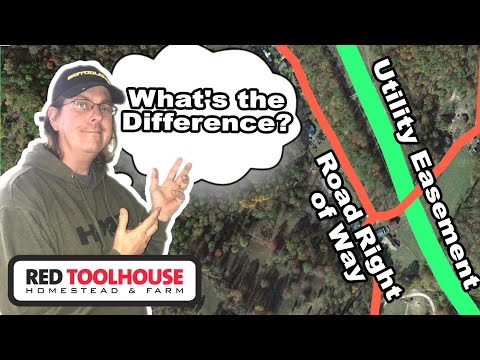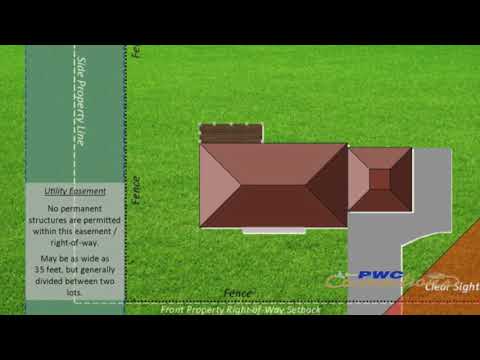Hold on, folks! We’re about to dip our toes into one of the most puzzling aspects of real estate. By the end, you’ll have a solid understanding of that mysterious term, the right of way easement. Gird your loins, it’s about to get educational – and we promise, it won’t be as dry as a dusty deed!

A Jargon-free Insight into Right of Way Easement
So, let’s get this show on the road with our first pit stop, which is understanding what exactly a right of way easement is. First off, let’s break it down – it’s not as complicated as it sounds. When we’re talking about an easement, we’re referring to the right someone has to use a piece of land that they don’t actually own. And when we say “right of way,” we simply mean the type of easement that lets someone pass through someone else’s property.
In plain English, it’s like that old dirt track that cuts across your neighbor’s field that the mailman uses to shave a few minutes off his route. He doesn’t own that land, but he’s got the right to use it – that’s a right of way easement.
Demystifying the Term: Right of Way Easement Definition
Alright, folks, let’s tackle the nitty-gritty: understanding the terms and legal parameters involved in a right of way easement.
Explaining an “Express Easement” in California Real Estate
Let’s take the land of golden sunsets, California, as an example. Over there, we have something called an express easement. Now, this isn’t some fast delivery service, but a right of way that’s directly granted by the property owner. Typically these are written right into the deed of the property, like a built-in feature of your new In-house mortgage plan.
Decoding the Concept of Utility Easement
Another term to get familiar with is utility easement. These easements allow utility companies, like electric, water, or communication lines, to pass through private property. You can think of it as the express lanes for essential services.
Clarifying How an Easement Holder Can Use the Land
The easement holder can use the property, but there are rules. It’s like borrowing an as Is car from your friend; you can drive it, but you can’t repaint it. This implies that the holder has rights to use the land for specific purposes but can’t alter or expand without the consent of the landowner.

Tip #1: Understanding the Power of Easement
In the world of real estate, understanding your easement powers is as crucial as knowing the right away meaning in traffic rules.
Emphasizing the Benefits of Written Contract or Implication
A well-drafted written easement prevents Risk-taking folks from insisting their routine trail across your lawn is a public right of way. No written agreement? No access – unless the path’s been in use under certain conditions for a really long time, creating a prescriptive easement.
Answering ‘Can a Property Owner Block an Easement?’
To answer the burning question, ‘can a property owner block an easement?‘ – it’s a resounding no. Whether you wake up on the wrong side of the bed or you’re grumpy from your Birkenstock Boston chafing you, you can’t block access without a legal process.

Tip #2: Getting a Clear Grasp of Easement Laws in Different States
Like your modular home Prices NC, easement laws vary from state to state.
The Easement Law in PA
For instance, in Pennsylvania, your claim to prescriptive easement requires 21 years of uninterrupted use. Think of it as a clock – when it starts ticking, you have a clear, continued pathway to the easement.
Easement Laws in Florida
Facing southwards to Florida, easement rights are earned over time as well. But, the Sunshine State adds a spicy twist – you have to use the land openly and notoriously. In other words, you can’t be sneaking around like a cat in the night.
Easement in Virginia
Over in the Old Dominion, Virginia, to claim a prescriptive easement, you’re required to prove use for 20 years. This isn’t a sprint; it’s a marathon!

Tip #3: Maximizing Benefits from Written Easements
Easements might feel like limitations, but with the right strategy, they can be favorable, just like those Reykjavik Hotels with a view of the Northern Lights!
Incorporating Easements in Deeds
An easement tied to the land deed carries over to new owners. So if you sell the property, the easement stays put – it’s like passing the baton in a relay race.
Advantages of Easements Transferring with Each Successive Owner
These transferring benefits provide peace of mind for utility companies and other easement holders. It’s like knowing your favorite coffee place won’t suddenly morph into a sushi bar overnight.
Tip #4: Utilizing Utility Easements to Your Advantage
Utility easements aren’t just convenient – they can be advantageous, too.
Utility companies often pay property owners for the rights to put their lines across the property. And, in some cases, you might even negotiate for free or discounted services. Just like leveraging your utilities, you might just negotiate a win-win scenario!

Tip #5: Strategizing the Management of Your Right of Way Easement
Remember, folks, understanding your rights forms the bedrock of a sound easement strategy.
Surrounding the seas of easement, landowners have limitations and permissions. For instance, they can’t lock the gate on an easement or install a loveable, but huge, Fluffy on the pathway.

Parting Wisdom: Your Next Steps for Advancing Easement Knowledge
Easement principles are neither as thrilling as bungee jumping nor as luxurious as vacationing at one of those Reykjavik Hotels. But knowing your terms places you in a powerful position, whether you’re an easement holder or a property owner wondering if it’s one in The same to have an easement.
Always muster the courage to seek legal advice when it comes to right of way easements and continue to learn more about real estate since this is where a lot of your lifelong wealth will be built!
: As of July 11, 2023.




